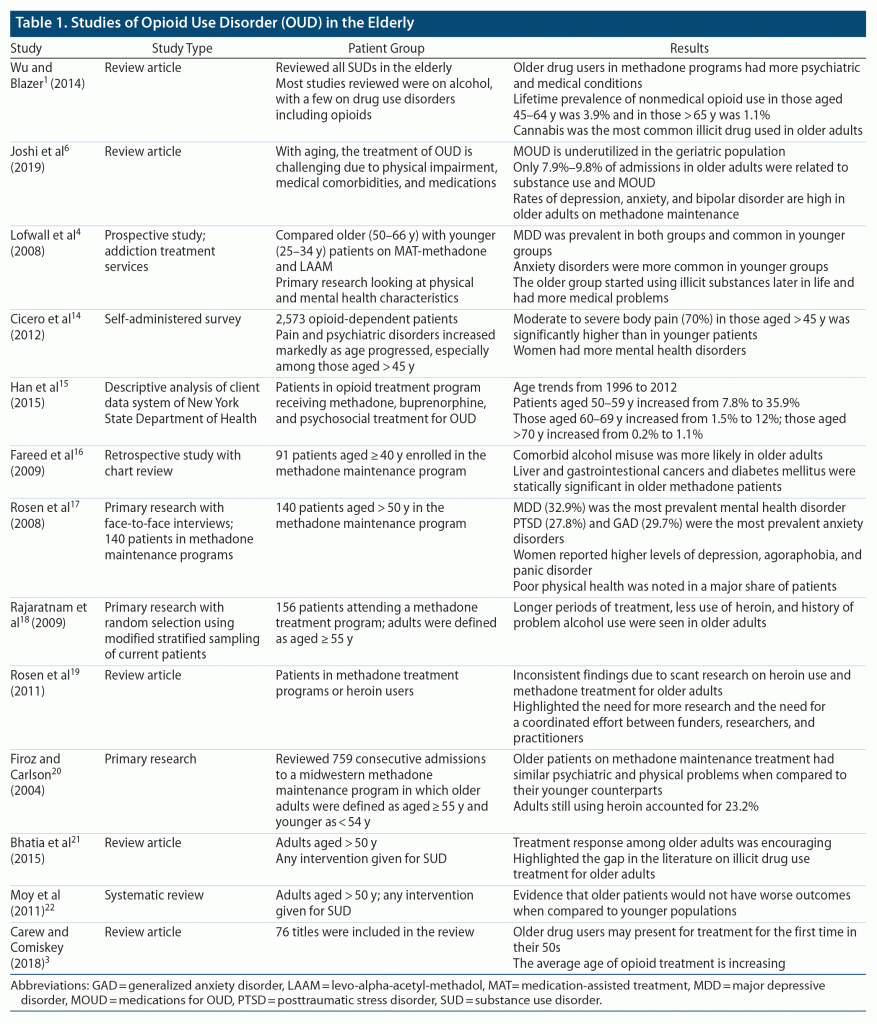ABSTRACT
Objective: US demographic trends show an increasing proportion of adults aged > 65 years old, approximately 1 million of whom are living with an opioid use disorder (OUD). OUD may be particularly problematic in this age group due to age-related pain syndromes and comorbidities that increase the risk of side effects, overdose, and death. The objective of this review was to assess the safety and efficacy of medications for OUD (MOUD) in the elderly.
Data Sources: A systematic search of the literature in PubMed, CINAHL, MEDLINE, Embase, and Cochrane Library databases was conducted from January 1992 through October 2021. The following terms were used: elderly, older adults, opioid use disorder, opioid dependence, buprenorphine, methadone, and medication-assisted treatment.
Study Selection: The search yielded 633 results. After following PRISMA guidelines and careful manual exclusion, 13 studies were selected for the review. No studies examining use of buprenorphine were identified for MOUD.
Results: The application of methadone for MOUD in the elderly shows that use is limited by preexisting conditions such as cardiac conduction abnormalities, which are more prevalent in the elderly than in the general population. Buprenorphine and naltrexone have been documented to have fewer interactions and potentially lethal adverse effects compared to methadone.
Conclusion: Future studies should focus on the application of buprenorphine or naltrexone for MOUD in the elderly.
Prim Care Companion CNS Disord 2023;25(1):21r03223
To cite: Konakanchi JS, Sethi R. The growing epidemic of opioid use disorder in the elderly and its treatment: a review of the literature. Prim Care Companion CNS Disord. 2023;25(1):21r03223.
To share: https://doi.org/10.4088/PCC.21r03223
© 2023 Physicians Postgraduate Press, Inc.
aDepartment of Psychiatry and Behavioral Sciences, University of Kansas Health System, Kansas City, Kansas
*Corresponding author: Roopa Sethi, MD, Department of Psychiatry and Behavioral Sciences, University of Kansas Health System, 3901 Rainbow Blvd, Kansas City, KS 66103 ([email protected]).
For much of the past century, the US economy has been dominated by the demands of the disproportionately large baby boomer generation (born between 1946 and 1964) as they moved through life. The needs of the baby boomers have set the benchmark for economic activity, innovation, and development as they began work, married, and raised their families. Today, as these individuals increasingly reach retirement age, the social, medical, and economic effects of aging have come into focus as services shift to address the demands for health care, elder care, medical devices, and related industries among this cohort. This change in focus intersects with the ongoing opioid use epidemic, raising new questions about the use of opioid medications in elderly patients and how to manage opioid use disorder (OUD) in an aging population.
The effects of aging impact all organ systems by affecting physiologic responsiveness, metabolism, and body composition, among other changes.1 Demographic trends in the United States show an increasing proportion of adults aged > 65 years with OUD. Studies2–4 have shown that many individuals who struggle with OUD have increasing life expectancies that sometimes surpass 65 years of age. Factors that may influence this trend are increased life expectancy in the general population, increased access to health care, increased recognition of OUD in this population, increased medication-assisted treatment services for OUD, and increased acceptance of harm reduction strategies in health care.4,5
Aging adults undergo many physiologic changes that make them more susceptible to organ injury, among other risks. With advancing age, the use and abuse of substances can alter neurotransmitter sensitivity in the brain, increasing the risk of neurotoxicity.1 In individuals requiring chronic medical treatment, illicit drug use may also exacerbate preexisting medical conditions in the form of interactions between prescribed medications and abused substances.1,6 Aging alters opioid pharmacokinetics by altering body composition and organ function. Changes in body composition associated with aging include an increase in adipose tissue, a decrease in lean body mass, and a decrease in total body water, which directly affect the distribution of drugs. As a result, lipophilic drugs tend to have a greater volume of distribution and take more time to be excreted from the body.7 Alterations in organ function and reductions in hepatic and renal blood flow volumes also affect the metabolism and excretion of chemicals. Altered organ function may affect the rate of phase I reactions like oxidation, hydroxylation, and dealkylation, impairing the metabolism of drugs.8 Age-related reductions in renal blood flow and glomerular filtration rate also impair the elimination of drugs.8 This is particularly significant when considering renally cleared opioids such as morphine and hydromorphone, for which a decrease in glomerular filtration rate can lead to more significant concentrations, thereby amplifying the risk and severity of adverse effects.9 Aging also alters pharmacodynamics via impaired neurotransmitter production and changes in receptor affinities.5 Because of these pharmacokinetic and pharmacodynamic changes associated with aging, opioids should be introduced at a lower dose—about 30%–50% of the respective dose given to younger patients.10,11 Advancing age, concomitant comorbidities, and other central nervous system depressants are reasons for vigilant monitoring in this subset of the population.
Three medications are approved for the treatment of OUD in the general population: methadone, buprenorphine, and naltrexone.12 All 3 medications bind to the μ-opioid receptor but have varying intrinsic activity at the receptor: methadone is a full agonist, buprenorphine is a partial agonist, and naltrexone is an antagonist at the receptor.12
METHODS
We conducted a systematic search of the literature in PubMed, CINAHL, Cochrane Library, Embase, and MEDLINE from January 1992 through October 2021. The search terms were elderly, older adults, opioid use disorder, opioid dependence, buprenorphine, methadone, and medication-assisted treatment. The search yielded 633 results. Retrospective studies, randomized controlled trials, prospective studies, review articles, surveys, and open-label studies were included in the review. Studies with transdermal buprenorphine, case reports, and case series were excluded. After careful manual exclusion based on our criteria and following PRISMA guidelines,13 13 studies1,3,4,6,14–22 were selected for the review (Figure 1).
RESULTS
We found no studies that systematically examined the use of buprenorphine for OUD in the elderly population, revealing an unmet medical need for future research (Table 1). Studies1,6 have shown that elderly adults with OUD suffer from a larger proportion of psychiatric and medical conditions compared to the general population. Major depressive disorder is the most prevalent mood disorder among elderly patients with concomitant substance use disorder; posttraumatic stress disorder and generalized anxiety disorder are the most common anxiety disorders in this population.4 Moderate to severe chronic pain is commonly present in the elderly compared to younger patients with OUD (Table 1).14
In general, only 8%–10% of the total admissions for elderly patients in the United States are related to substance use and medications for OUD (MOUD), yet abuse of illicit and prescribed drugs is higher in this population compared to the general population.6 Statistical data gathered from 1996 to 2012 by the client data system of the New York State Department of Health show an increase in substance use for elderly patients. Trends show that in those aged 50–59 years, there was an increase in prevalence from 7.8% to 35.9%, for those aged 60–69 years there was an increase from 1.5% to 12%, and for individuals aged ≥ 70 years, prevalence increased from 0.2% to 1.1%.15
Data also show that in the elderly population, patients are more likely to obtain opioids from a medical source as opposed to obtaining them illicitly, such as in the general population.14 Trends have also shown a decrease in heroin use since 1996, with a contrasting increase in the use of opioids in oral formulations. Additionally, it is also worth noting that nonmedical use of prescription opioids (Darvocet, Percocet, Vicodin, hydrocodone) has a higher past-year prevalence rate than other prescription drugs.1
When considering MOUD in the elderly population, factors such as physical limitations, stamina, cognitive impairments, compliance to treatment, living arrangements, and accessibility to care become important factors in deciding on the most appropriate medication.20 It can be challenging for older adults to access methadone clinics because of the added burden of daily commutes to receive medications. Buprenorphine, a partial agonist, has fewer withdrawal symptoms and little to no cardiac conduction effects, making it a more tolerable agent in the elderly.6 When initiating buprenorphine treatment, there are certain factors to be considered, such as medical complications that may be more prevalent among the elderly population, requiring a dedicated examination and delineation of best practice. With this population, particular attention should be given to the emergence of adverse effects that may devolve into life-threatening complications, such as constipation and bowel obstruction, vomiting and electrolyte imbalances, and dizziness and falls. Implementing a gradual dose escalation, as well as monitoring for medication interactions and fall risk,23–25 will prove to be essential for the management of MOUD in this population. Of the available literature, buprenorphine was shown to be well tolerated in older patients and efficacious for pain management with retained functional capacity.26,27
CONCLUSION
Statistical trends have shown an increase favoring the use and abuse of prescription opioids over heroin since 1996 in the general population. A dramatic increase in opioid use disorders has been documented during this timeline in individuals over age 65 years, who are more prone to having coexisting medical conditions or to developing adverse effects or complications. Available treatment options for this population include methadone, buprenorphine, and naltrexone. A systematic review of studies using methadone for MOUD in this population shows that application of this drug is limited by preexisting conditions, such as cardiac conduction abnormalities, which are more prevalent in this age group than in the general population. Buprenorphine has been documented to have less interactions and potentially lethal adverse effects compared to methadone, making it a more preferred candidate for MOUD in the elderly. Future studies in this area should focus on the application of buprenorphine for MOUD in individuals aged > 65 years.
Submitted: December 20, 2021; accepted April 29, 2022.
Published online: January 10, 2023.
Relevant financial relationships: Dr Sethi and Ms Konakanchi have no relevant financial relationships to disclose.
Funding/support: None.
Acknowledgment: The authors acknowledge Jose Perez Martell, MD (Department of Psychiatry and Behavioral Sciences, University of Kansas Health System, Kansas City, Kansas) for his help with the article. Dr Martell has no relevant financial relationships to disclose.
CLINICAL POINTS
- US demographic trends show an increasing proportion of adults aged > 65 years, with close to 1 million individuals in this group living with opioid use disorder (OUD).
- OUD is complicated to treat in older adults due to age-related pain syndromes and comorbidities that increase the risk of side effects, overdose, and death.
- Buprenorphine and naltrexone have been documented to have fewer interactions and potentially lethal adverse effects compared to methadone for OUD.
References (27)

- Wu L-T, Blazer DG. Substance use disorders and psychiatric comorbidity in mid and later life: a review. Int J Epidemiol. 2014;43(2):304–317. PubMed CrossRef
- Substance Abuse and Mental Health Services Administration. Results from the 2018 National Survey on Drug Use and Health: Detailed tables. Rockville, MD: Center for Behavioral Health Statistics and Quality, Substance Abuse and Mental Health Services Administration. Accessed July 5, 2022. https://www.samhsa.gov/data
- Carew AM, Comiskey C. Treatment for opioid use and outcomes in older adults: a systematic literature review. Drug Alcohol Depend. 2018;182:48–57. PubMed CrossRef
- Lofwall MR, Schuster A, Strain EC. Changing profile of abused substances by older persons entering treatment. J Nerv Ment Dis. 2008;196(12):898–905. PubMed CrossRef
- Colliver JD, Compton WM, Gfroerer JC, et al. Projecting drug use among aging baby boomers in 2020. Ann Epidemiol. 2006;16(4):257–265. PubMed CrossRef
- Joshi P, Shah NK, Kirane HD. Medication-assisted treatment for opioid use disorder in older adults: an emerging role for the geriatric psychiatrist. Am J Geriatr Psychiatry. 2019;27(4):455–457. PubMed CrossRef
- Linnebur SA, O’Connell MB, Wessell AM, et al; ACCP Task Force. Pharmacy practice, research, education, and advocacy for older adults. Pharmacotherapy. 2005;25(10):1396–1430. PubMed CrossRef
- Tegeder I, Lötsch J, Geisslinger G. Pharmacokinetics of opioids in liver disease. Clin Pharmacokinet. 1999;37(1):17–40. PubMed CrossRef
- Hines LA, Trickey A, Leung J, et al. Associations between national development indicators and the age profile of people who inject drugs: results from a global systematic review and meta-analysis. Lancet Glob Health. 2020;8(1):e76–e91. PubMed CrossRef
- Clark P. Pharmacologic pain management on the elderly cancer patient. Presented at the 26th Congress of the Oncology Nursing Society. May 17, 2002; San Diego, CA.
- Davis MP, Srivastava M. Demographics, assessment and management of pain in the elderly. Drugs Aging. 2003;20(1):23–57. PubMed CrossRef
- Abuse S. Mental Health Services Administration (SAMHSA). TIP 63: Medications for Opioid Use Disorder: For Healthcare and Addiction Professionals, Policymakers, Patients, and Families. Accessed July 5, 2022. https://store.samhsa.gov/shin/content//SMA18-5063FULLDOC/SMA18-5063FULLDOC.pdf
- Page MJ, McKenzie JE, Bossuyt PM, et al. The PRISMA 2020 statement: an updated guideline for reporting systematic reviews. BMJ. 2021;372(71):n71. PubMed CrossRef
- Cicero TJ, Surratt HL, Kurtz S, et al. Patterns of prescription opioid abuse and comorbidity in an aging treatment population. J Subst Abuse Treat. 2012;42(1):87–94. PubMed CrossRef
- Han B, Polydorou S, Ferris R, et al. Demographic trends of adults in New York City opioid treatment programs: an aging population. Subst Use Misuse. 2015;50(13):1660–1667. PubMed CrossRef
- Fareed A, Casarella J, Amar R, et al. Benefits of retention in methadone maintenance and chronic medical conditions as risk factors for premature death among older heroin addicts. J Psychiatr Pract. 2009;15(3):227–234. PubMed CrossRef
- Rosen D, Smith ML, Reynolds CF 3rd. The prevalence of mental and physical health disorders among older methadone patients. Am J Geriatr Psychiatry. 2008;16(6):488–497. PubMed CrossRef
- Rajaratnam R, Sivesind D, Todman M, et al. The aging methadone maintenance patient: treatment adjustment, long-term success, and quality of life. J Opioid Manag. 2009;5(1):27–37. PubMed CrossRef
- Rosen D, Hunsaker A, Albert SM, et al. Characteristics and consequences of heroin use among older adults in the United States: a review of the literature, treatment implications, and recommendations for further research. Addict Behav. 2011;36(4):279–285. PubMed CrossRef
- Firoz S, Carlson G. Characteristics and treatment outcome of older methadone-maintenance patients. Am J Geriatr Psychiatry. 2004;12(5):539–541. PubMed CrossRef
- Bhatia U, Nadkarni A, Murthy P, et al. Recent advances in treatment for older people with substance use problems: an updated systematic and narrative review. Eur Geriatr Med. 2015;6(6):580–586. CrossRef
- Moy I, Crome P, Crome I, et al. Systematic and narrative review of treatment for older people with substance problems. Eur Geriatr Med. 2011;2(4):212–236. CrossRef
- Boone M, Brown NJ, Moon MA, et al. Clinical Guidelines for the Use of Buprenorphine in the Treatment of Opioid Addiction. Treatment Improvement Protocol (TIP) Series 40. SAMHSA’s National Clearinghouse for Alcohol and Drug Information (NCADI). Accessed July 5, 2022. https://eric.ed.gov/?id=ED491569
- Edelman EJ, Chantarat T, Caffrey S, et al. The impact of buprenorphine/naloxone treatment on HIV risk behaviors among HIV-infected, opioid-dependent patients. Drug Alcohol Depend. 2014;139:79–85. PubMed CrossRef
- Renner JA Jr, Levounis P, LaRose AT. Office-Based Buprenorphine Treatment of Opioid Use Disorder. 2nd ed. American Psychiatric Association Publishing; 2017.
- Malinoff HL, Barkin RL, Wilson G. Sublingual buprenorphine is effective in the treatment of chronic pain syndrome. Am J Ther. 2005;12(5):379–384. PubMed CrossRef
- Nasar MA, McLeavy MA, Knox J. An open study of sub-lingual buprenorphine in the treatment of chronic pain in the elderly. Curr Med Res Opin. 1986;10(4):251–255. PubMed CrossRef
Save
Cite
Advertisement
GAM ID: sidebar-top






